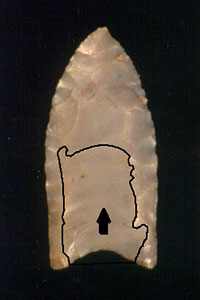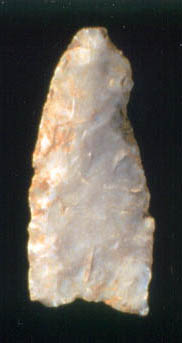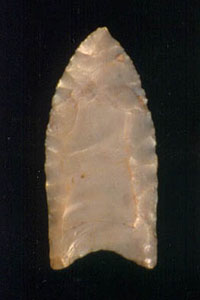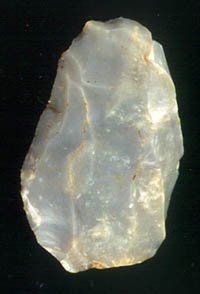Fluted points are by far the most widely known and easily recognizable stone tools of the Paleoindian period. These tools are key to identifying the site as a Paleoindian encampment, since fluting does not occur on projectile points made after the Paleoindian era. The particular style of fluting at Nobles Pond suggests that the points were made sometime between 11,000 and 11,200 years ago.
A fluted point is a bifacial tool (that is, flaked on both the front and the back). Fluted points have a concave base at one end and a pointed tip at the other end. A flute or channel extends from the base partway to the tip (see below for a description of fluting). The point would be attached to a shaft, to serve as the tip of a spear, javelin or atlatl-type dart.
Not all Paleoindian sites have fluted points, but the Nobles Pond collection includes many fluted points and preforms. (Preforms are bifaces at some intermediate stage of manufacture, on their way to becoming fluted points.)
The Nobles Pond collection includes:
- 48 finished points (including pieces)
- 47 preforms (including pieces)
What Is Fluting?

Fluting is the removal of one or more flakes from the biface, starting from the base, moving toward the tip. This creates a groove or channel on the face of the biface. Most often (but not always), if one side is fluted, then both sides are fluted.
We do not know why Paleoindians fluted their spear points. It might have to do with the way that they attached shafts to their spear points. Perhaps fluting was a way to reduce the cross-section of the spear to allow easier or deeper penetration. However, since the shafts were made of perishable material (probably wood or bone), no one has yet found a point still attached to its shaft. So we do not have any direct evidence for this theory.
Fluted Point Manufacture
Points, preforms, and manufacturing debris from Nobles Pond clearly show that some fluted points were made, used, and then discarded at the site. But the evidence also shows that some of the points found at Nobles Pond were made elsewhere and brought to the site in a used-up condition. Moreover, some of the points made at Nobles Pond were carried away for use elsewhere when the Paleoindians moved on.
The cherts ("flints") used to make the fluted points and preforms are (roughly) half high-quality Upper Mercer and half Flint Ridge from east central Ohio. There are also four points/preforms made of Attica chert (from western Indiana), one of Bloomville chert, and one of an undetermined chert type.
Also, one channel flake (waste flake from fluting) of Wyandotte chert (from southern Indiana) was found at Nobles Pond, although no fluted points or preforms of Wyandotte were recovered from the site.
Fluted Point Use
Fluted points were used primarily in hunting, serving as the tips of spears, javelins or atlatl-type darts.
Protein residue testing suggests that the Paleoindians hunted a variety of animals. The predominance of cervid (deer-related) residue on Paleoindian end scrapers suggests that hunting focused primarily on caribou, elk and/or white-tailed deer, with occasional hunting of other animals (both large and small).
Fluted Point Maintenance

Many of the finished points in the Nobles Pond collection are small base fragments that were broken in use and discarded, having been replaced by new points or possibly by reworked tips.
Hitting bone or stone (from a miss-throw) might break the tip of a spear point, resulting in a distinct type of breakage known as an impact fracture. If the damage was not too extensive, a Paleoindian might try to salvage the point by reworking it to approximate a complete point.
Discussion
White-tailed deer or caribou were probably the preferred prey of the Nobles Pond Paleoindians. They would have provided the Paleoindians with a lot of meat, and their hides could be used for warm clothing (such as parkas), tent covers, snow-shoe webbing and more. Also, a white-tailed deer or a caribou can be brought down with a single well-placed hit from a spear, javelin or atlatl dart. By contrast, a single hit, however well-placed, might not have been fatal to larger prey, such as elk, moose, bison, or mastodon.
The Paleoindians might have come to Nobles Pond to hunt caribou by intercepting a seasonal caribou migration, as was the case at the Vail Paleoindian site in Maine.



